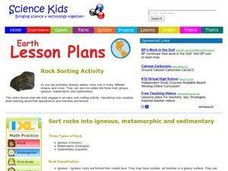Curated OER
Rocks: Mineral Mixtures
A 22-slide set provides pretty much everything you need to teach the rock cycle except the actual specimens. All of the slides contain graphics or photographs to help describe the process, and most even have links to educational videos....
Curated OER
Regents High School Examination: Physical Setting Earth Science 2006
Test your class on earth science with this extensive resource. This test, created by The University of the State of New York Regents, is made up of 50 multiple choice questions and 32 short answer questions that cover the branches of...
Curated OER
Rocks Worksheet #1
There's not much to this geology handout. There are black and white drawings of five rocks on the top: basalt, gneiss, conglomerate, granite, and sandstone. Five multiple choice questons regarding characteristics and formation of the...
Curated OER
A Rock’n Earth
Seventh graders identify the three types of rocks. For this earth science lesson, 7th graders model the rock cycle using crayon shaving. They explain how rocks change as they go through the cycle.
Curated OER
Rock Cycle Activity
A few of the components of this lesson are not possible to carry out because the rock cycle diagram and challenge handouts are not included. Hopefully, you already have your own rock cycle diagram or worksheet to use as a concept...
Curated OER
Science Jeopardy - Virginia Geology
Unique in content, this Jeopardy-style game quizzes participants on the geology of the state of Virginia. Categories include provinces, east or west, under the surface, once alive, and fun facts. Other than teachers of upper elementary...
Curated OER
The Earth and Rocks
There are inconsistencies in the information included on each slide. For example, physical characteristics are listed for sedimentary rocks, but formation is mentioned for metamorphic rocks. For igneous rocks, characteristics and a hint...
Curated OER
Rock Sorting Activity
Students organize rock samples according to their properties. In this earth science lesson plan, students predict whether they are igneous, metamorphic or sedimentary. They compare their prediction with the actual type.









